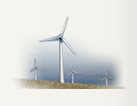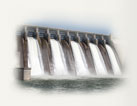Renewable Sources
The idea of drawing our energy from sources that are renewable, are independent of foreign nations, and do not emit greenhouse gases has powerful appeal. But capturing these resources is expensive, and many are intermittent, which complicates using them on a large scale. Learn about renewable sources’ current contributions to our energy supply and their prospects for our energy future.

The United States generates more electricity from geothermal energy than any other country in the world.
Geothermal energy is a domestic energy source with relatively benign effects on the environment. So why does it only contribute 0.2% to the total U.S. energy supply?
More about geothermal

In the United States, the amount of electricity generated from wind doubled between 2010 and 2015 and now makes up 19% of all renewable energy consumed and almost 2% of total U.S. energy use.
Wind accounts for a very small part of our total energy production but it has been growing in the past few years. Find out how this renewable technology is contributing to our supply of electricity.
More about wind

About 0.6% of the total energy consumed in the United States came from photovoltaic and solar thermal sources in 2015, but that share is growing.
Sunlight is Earth’s most abundant energy source. Yet capturing and converting its energy into usable forms is a challenge. Learn how solar energy is currently being used and the obstacles to expanding its use.
More about solar

Hydroelectric sources produced about one-fourth of all U.S. renewable energy consumed in 2014 and about 2.5% of total energy consumed.
Of the renewable energy sources used to generate electricity in the United States, hydropower makes the biggest contribution. Water used to spin a turbine is a cheap, non-polluting domestic source of energy. But hydropower brings with it other environmental impacts to consider.
More about hydroelectric

Wood and waste biomass, along with biofuels, accounted for about 50% of the U.S. renewable energy supply in 2014 and more than 4% of all energy consumed.
Of all the renewable sources, biomass contributes the most to the U.S. energy supply. Find out how methane from landfills, grain alcohol from corn, and even heat from municipal waste help power our nation.
More about biomass
